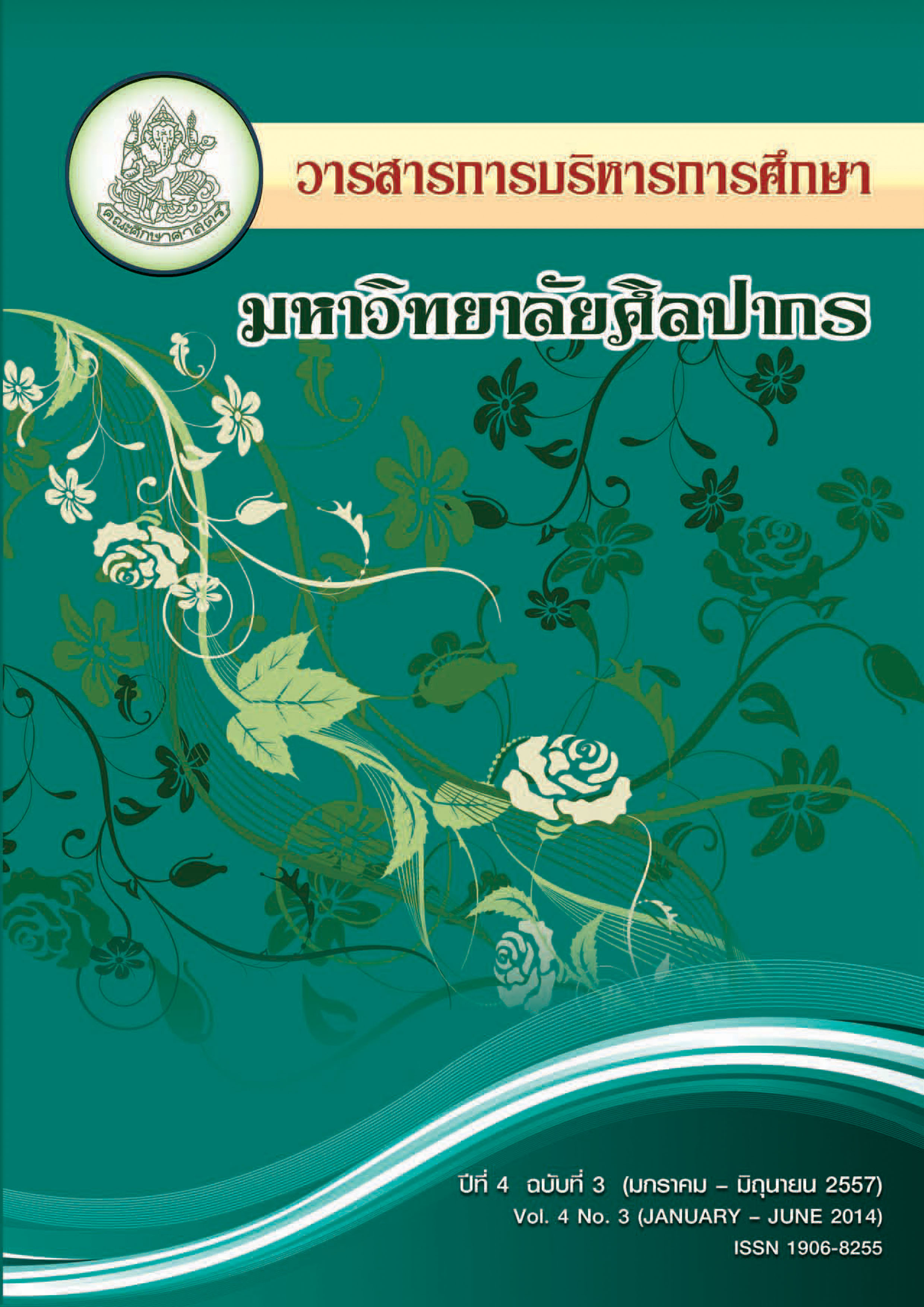การพัฒนารูปแบบการจัดการเรียนรู้ที่ส่งเสริมการปลูกจิตสำนึกสุจริต ให้กับนักเรียน โรงเรียนบ้านหาดแพง (หาดแพงวิทยา)
บทคัดย่อ
การวิจัยครั้งนี้มีวัตถุประสงค์เพื่อ 1) ศึกษาสภาพการจัดการเรียนรู้ที่ส่งเสริมการปลูกจิตสำนึกสุจริตให้กับนักเรียนโรงเรียนบ้านหาดแพง (หาดแพงวิทยา) 2) สร้างรูปแบบการจัดการเรียนรู้ที่ส่งเสริมการปลูกจิตสำนึกสุจริตให้กับนักเรียนโรงเรียนบ้านหาดแพง (หาดแพงวิทยา) 3) ทดลองใช้รูปแบบการจัดการเรียนรู้ที่ส่งเสริมการปลูกจิตสำนึกสุจริตให้กับนักเรียนโรงเรียนบ้านหาดแพง (หาดแพงวิทยา) 4) ศึกษาความพึงพอใจของครู คณะกรรมการสถานศึกษาขั้นพื้นฐาน ผู้ปกครอง และนักเรียน ต่อรูปแบบการจัดการเรียนรู้ที่ส่งเสริมการปลูกจิตสำนึกสุจริตให้กับนักเรียนโรงเรียนบ้านหาดแพง (หาดแพงวิทยา) กลุ่มตัวอย่างที่ใช้ในการวิจัยครั้งนี้ ได้แก่ ครูโรงเรียนบ้านหาดแพง จำนวน 8 คน คณะกรรมการสถานศึกษาขั้นพื้นฐาน จำนวน 4 คน นักเรียนชั้นประถมศึกษาปีที่ 4 - ชั้นมัธยมศึกษาปีที่ 3 จำนวน 86 คน และผู้ปกครองนักเรียน จำนวน 86 คน รวมทั้งสิ้น 184 คน เครื่องมือที่ใช้ในการวิจัยครั้งนี้เป็นแบบประเมินคุณลักษณะความสุจริต และแบบประเมินความพึงพอใจ สถิติที่ใช้ในการวิเคราะห์ข้อมูล ได้แก่ ร้อยละ (%) ค่าเฉลี่ย (ผลการวิจัยพบว่า
1. สภาพการจัดการเรียนรู้ที่ส่งเสริมการปลูกจิตสำนึกสุจริตให้กับนักเรียนอย่างหลากหลายประกอบด้วย กิจกรรมใน 3 ลักษณะ คือ กิจกรรมปลูกฝัง กิจกรรมป้องกัน และกิจกรรมประสานชุมชน
2. รูปแบบการจัดการเรียนรู้ที่ส่งเสริมการปลูกจิตสำนึกสุจริตให้กับนักเรียนโรงเรียนบ้านหาดแพง (หาดแพงวิทยา) คือ รูปแบบ 3-3-3 ประกอบด้วย 1) กิจกรรมการปลูกฝัง ได้แก่ กิจกรรมเด็กดีศรีหาดแพง กิจกรรมธนาคารความดี และกิจกรรมออม ทรัพย์ 2) กิจกรรมการป้องกัน ได้แก่ กิจกรรมเดินตามรอยเท้าพ่อ กิจกรรมนิทานคุณธรรม และกิจกรรมโครงงานคุณธรรม 3) กิจกรรมประสานชุมชน ได้แก่ กิจกรรมรณรงค์สุจริต กิจกรรมสุจริตเริ่มที่บ้าน และกิจกรรมวัดสู่โรงเรียน
3. ผลการทดลองใช้รูปแบบการจัดการเรียนรู้ที่ส่งเสริมการปลูกจิตสำนึกสุจริตให้กับนักเรียนโรงเรียนบ้านหาดแพง (หาดแพงวิทยา) ปรากฏผล ดังนี้ 3.1 นักเรียนโรงเรียนบ้านหาดแพง (หาดแพงวิทยา) มีคุณลักษณะความสุจริต ระดับคุณภาพดีเยี่ยมร้อยละ 75.63 ระดับคุณภาพดีร้อยละ 21.94 และระดับผ่านร้อยละ 2.43 3.2 นักเรียนโรงเรียนบ้านหาดแพง (หาดแพงวิทยา) มีคะแนนคุณลักษณะความสุจริตหลังเรียนสูงกว่าก่อนเรียน อย่างมีนัยสำคัญทางสถิติที่ระดับ .01
4. ครู คณะกรรมการสถานศึกษาขั้นพื้นฐาน ผู้ปกครอง และนักเรียนมีความพึงพอใจต่อรูปแบบการจัดการเรียนรู้ที่ ส่งเสริมการปลูกจิตสำนึกสุจริตให้กับนักเรียนโรงเรียนบ้านหาดแพง (หาดแพงวิทยา) อยู่ในระดับมากที่สุด
DEVELOPMENT LEARNING MODEL FOR GROWING AN HONESTY CONSCIOUSNESS FOR STUDENT OF BAAN HADPHAENG SCHOOL (HADPHAENGWITTAYA)
The purposes of this research were to study 1) predicament learning pattern for enhancing honesty consciousness of the students in Baan Hadphaeng School (Hadphaeng Wittaya), 2) to create the learning pattern for enhancing honesty consciousness of the students in Baan Hadphaeng School (Hadphaeng Wittaya), 3) to practice the learning pattern for enhancing honesty consciousness of the students in Baan Hadphaeng School (Hadphaeng Wittaya), 4) to determine satisfaction of teachers, school board, parent, and students to the learning pattern. The samples were 8 teachesr, 4 school board, 86 parrent and 86 students, total of 184. The 2 instruments used in this research were the questionnaire of evaluation quality of honesty and the evaluation satisfaction. The statistical analyses were IOC, means, standard deviation and t-test dependent. Results illustrated that
1) a draft of the learning pattern consisted of educating activity, protective activity and community integrating activity
2) the learning pattern was 3-3-3 comprising several activities including 1) educating activity : Hadphaeng’s good children, Goodness bank, Saving scheme 2) protective activity : Follow the King project, Virtue telling story, Virtue projects
3) Community integrating activity : Honesty campaign, Honest starting at home project, From temple to school project 3) the implementation of the learning pattern indicated that 1) 75.63% of the Hadphaeng students had excellent honesty habits and 21.94% of the students had good honesty habits, while 2.43% of students were just acceptable 2) statistical analysis of the score difference between before and after learning depicted that the students had higher score of honesty after being educated significantly at P=0.01
4) the satisfaction of sampling groups to the implementation of the learning pattern was at the highest level.




